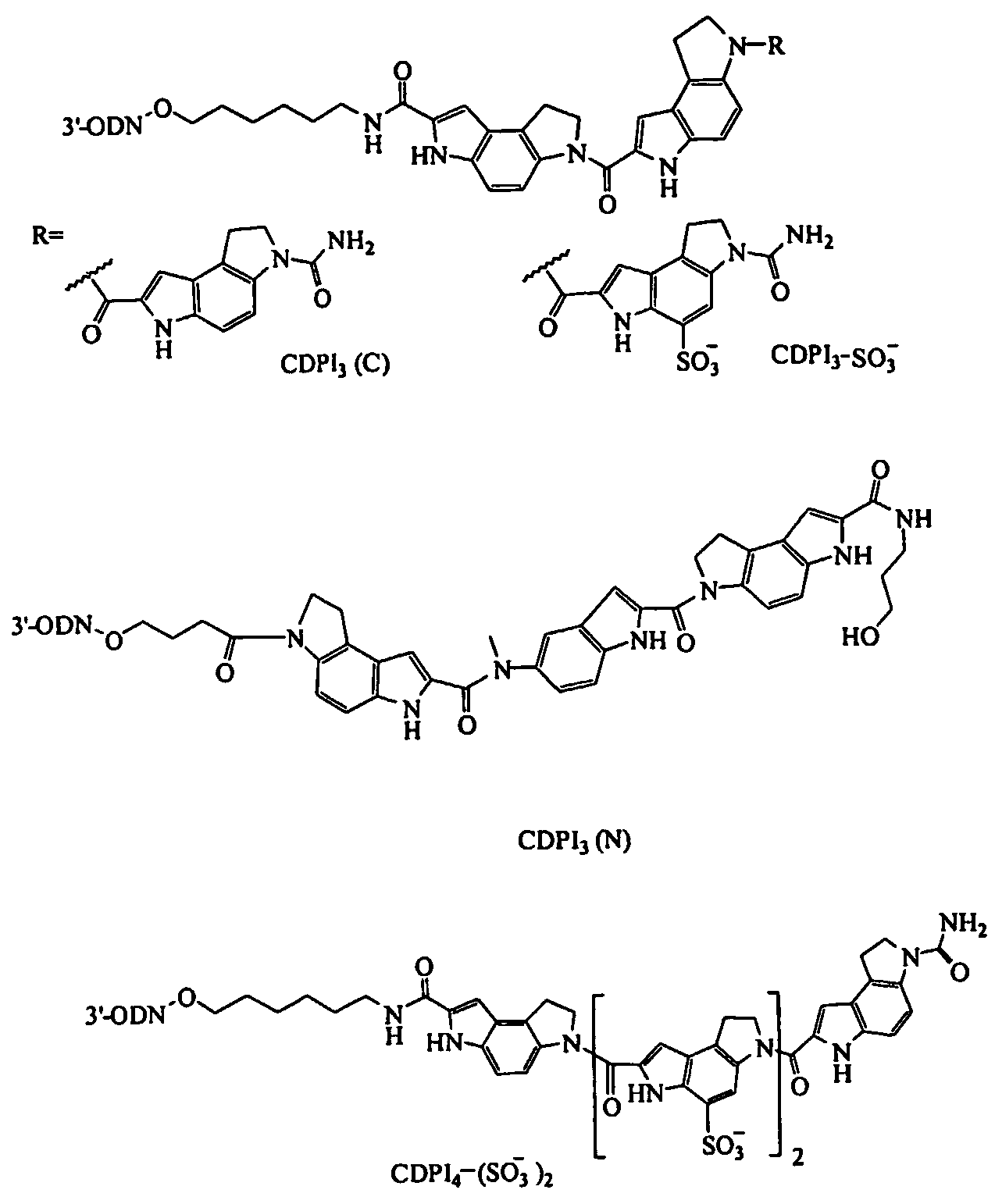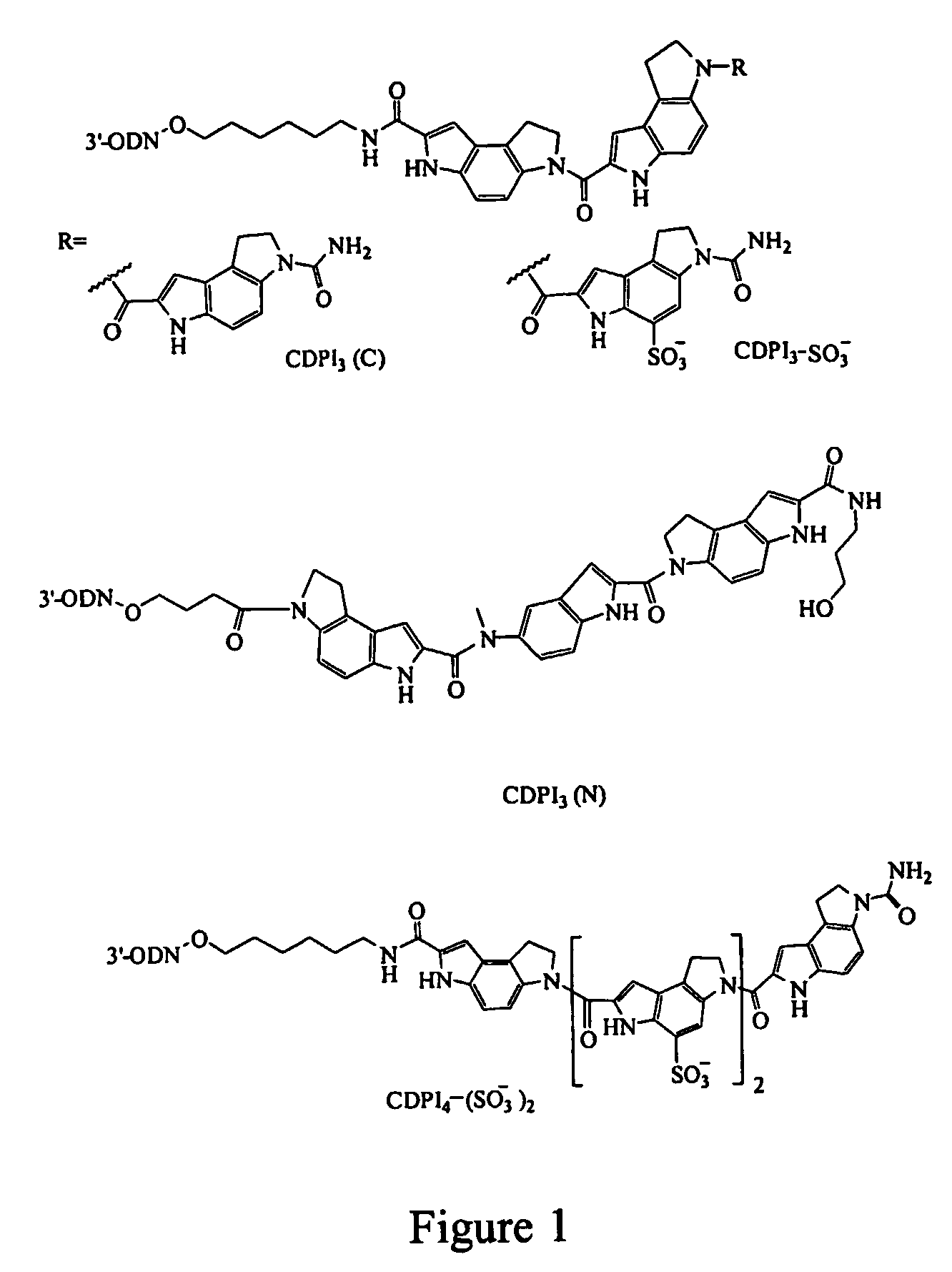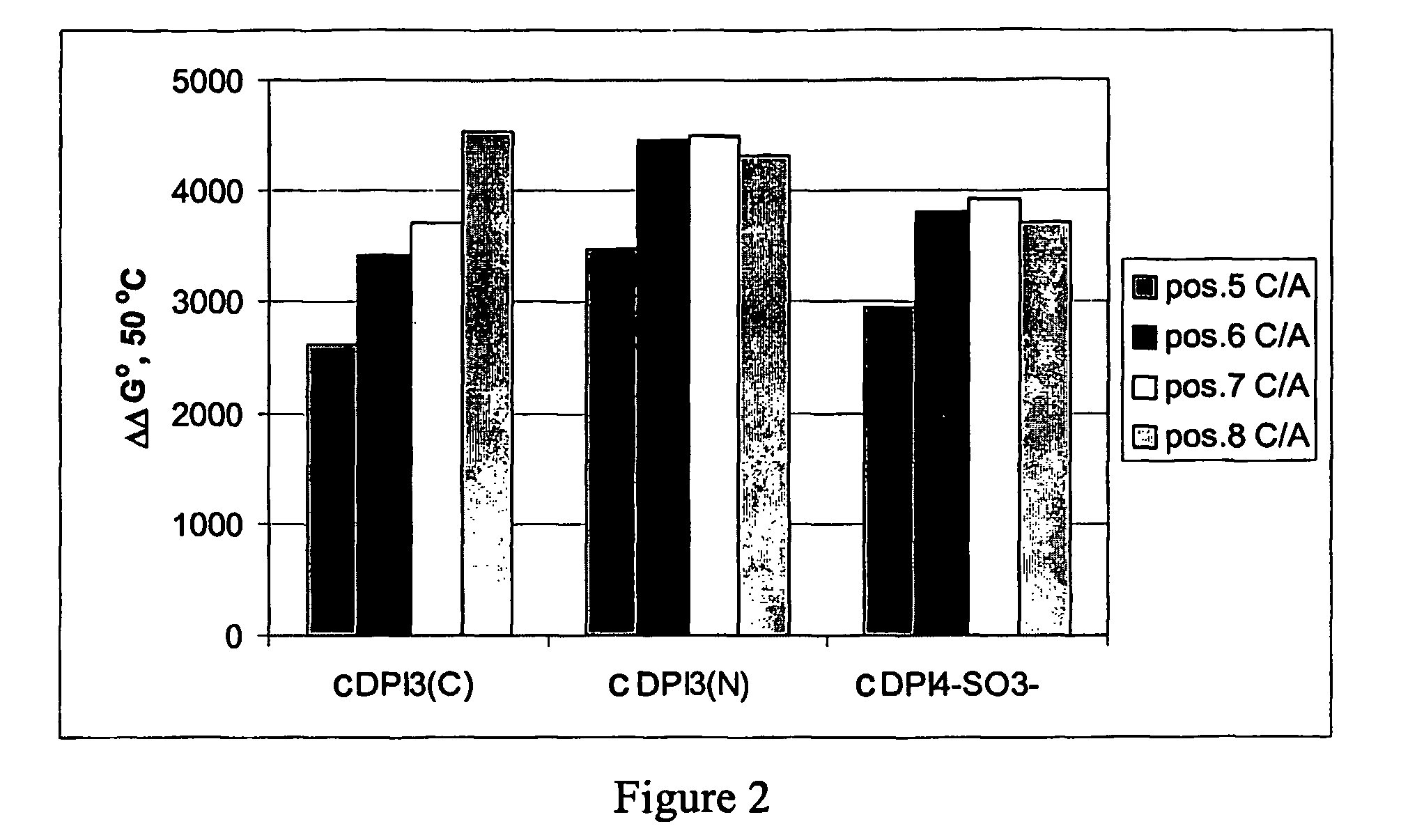Negatively charged minor groove binders
a negative charge, minor groove technology, applied in the direction of microorganism testing/measurement, biochemistry apparatus and processes, organic chemistry, etc., can solve the problems of aggregation reducing the effective concentration and consequently the performance of minor groove binders. performance, and the effect of positive charg
- Summary
- Abstract
- Description
- Claims
- Application Information
AI Technical Summary
Benefits of technology
Problems solved by technology
Method used
Image
Examples
example 1
[0400]This example illustrates a method for producing 3-[(tert-butyl)oxycarbonyl]-7-[(2,3,4,5,6-pentafluoropheny)oxycarbonyl]pyrrolo[3,2-e]indoline-5-sulfonic acid (Compound 1-2 in Scheme II)
Synthesis of 1-acetylindoline-6-sulfonic acid (Compound 2-2 in Scheme II)
[0401]Indoline-6-sulfonic acid (Compound 2-1 in Scheme II) (20 g), which was prepared according to the procedure described in U.S. Pat. No. 4,405,788, was dissolved in 200 mL of anhydrous DMF in the presence of 20 mL of triethylamine. Acetic anhydride (12 mL) was added, and the resulting solution was kept at room temperature for 8 h. DMF was evaporated and the residue was diluted with 100 mL of water. Concentrated sulfuric acid (20 mL) was added slowly with cooling. The product was allowed to crystallize overnight at 4° C. The crystals were collected by filtration and washed with small amount of cold water followed by acetone. Drying under vacuum over P2O5 afforded 18.6 g of the desired product as white crystals. 1H MNR (d6...
example 2
[0409]This example illustrates a method for synthesizing CDPI-trimer (i.e., CDPI3) derivative of the present invention.
[0410]
Synthesis of 3-[(tert-butyl)oxycarbonyl]-7-[(7-{[2-4-nitrophenyl)ethyl]oxycarbonyl}-pyrrolo[3,2-e]indolin-3-yl)carbonyl]pyrrolo[3,2-indoline-5-sulfonic acid, triethylammonium salt (13)
[0411]2-(4-Nitrophenyl)ethyl 3-[(tert-butyl)oxycarbonyl]pyrrolo[4,5-e]indoline-7-carboxylate (1.62 g) (Compound 1-1 of Scheme I) was selectively deprotected by treatment with 15 mL of trifluoroacetic acid (i.e., TFA) for 1 h. TFA was evaporated to afford a TFA salt of amine 12. Residual TFA was removed by co-evaporation with ether followed by drying under vacuum. The TEA salt was dissolved in 30 mL of anhydrous DMF in the presence of 0.9 mL of triethylamine. Compound 1-2 of Scheme II (see Example 1) (1.86 g) was added and the reaction was stirred at room temperature overnight. The solvent was evaporated under vacuum and the semi-solid residue was triturated with 10% MeOH / dichloro...
example 3
[0414]This example illustrates a method for synthesizing CDPI-tetramer (i.e., DPI4 or CDPI4) derivative of the present invention.
[0415]
Synthesis of 3-({3-[(tert-butyl)oxycarbonyl]-5-sulfopyrrolo[4,5-e]indolin-7-yl}carbonyl)-7-[(7-{[2-(4-nitrophenyl)ethyl]carbonyl]pyrrolo[3,2-e]indoline-5-sulfonic, ditriethylammonium salt (16)
[0416]A suspension of Compound 13 (2.1 g) (see Example 2) in 20 mL of TFA was stirred at room temperature for 1 h. TFA was evaporated and the resulting solid was washed with ether to remove residual TFA. After being dried in vacuo for 1 h, the solid was dissolved in 20 mL of anhydrous DMF in the presence of 1.0 mL of triethylamine. To this solution was added Compound 1-2 (Scheme II) (1.6 g) (see Example 1). The resulting reaction mixture was stirred overnight to give a suspension. DMF was evaporated and the solid was washed with methanol, ether and dried under vacuum to afford 2.8 g of the title Compound 16. 1H MNR (d6-DMSO) δ: 11.97 (s, 1H, NH), 10.39 (s, 1H, N...
PUM
| Property | Measurement | Unit |
|---|---|---|
| pKa | aaaaa | aaaaa |
| emission wavelength | aaaaa | aaaaa |
| Ri | aaaaa | aaaaa |
Abstract
Description
Claims
Application Information
 Login to View More
Login to View More - R&D
- Intellectual Property
- Life Sciences
- Materials
- Tech Scout
- Unparalleled Data Quality
- Higher Quality Content
- 60% Fewer Hallucinations
Browse by: Latest US Patents, China's latest patents, Technical Efficacy Thesaurus, Application Domain, Technology Topic, Popular Technical Reports.
© 2025 PatSnap. All rights reserved.Legal|Privacy policy|Modern Slavery Act Transparency Statement|Sitemap|About US| Contact US: help@patsnap.com



